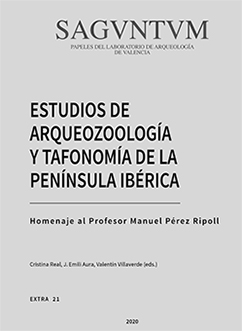Estudio experimental del procesado de carcasas de aves. Interpretando el consumo de anátidas en contextos paleolíticos
 Resumen
Resumen
The importance of small prey exploitation in Palaeolithic and Epipalaeolithic hunter-gatherer communities is being re-evaluated thanks to the proliferation of experimental and neotaphonomic studies. A special interest has been devoted to leporid remains, what is evident from the significant number of new referential studies that have been recently published. However, despite their abundance in the archaeological record, fewer studies have been focused to establish the human taphonomic signature on avian assemblages.
This paper presents the results obtained from an experimental study about the processing of carcasses of anatids, specifically wood duck (Aix sponsa Linnaeus 1758). The activities conducted include the skinning, feathers extraction, disarticulation and defleshing of the avian carcasses. These activities were performed using lithic tools of different quality and by people with different skills. The results show that the location, intensity and orientation of some marks are useful to discriminate between the different butchery activities performed, contributing to the interpretation of the ornithoarchaeological record in prehistoric sites.
 Descargas
Descargas
Descargas
Publicado
Cómo citar
-
Resumen324
-
PDF148
Número
Sección
Licencia

Este obra está bajo una licencia de Creative Commons Reconocimiento-NoComercial-SinObraDerivada 4.0 Internacional.
Con la publicación impresa de los trabajos, los/as autores/as aceptan que el Departament de Prehistòria, Arqueologia i Història Antiga de la Universitat de València pueda permitir la difusión y el libre acceso a través de las direcciones electrónicas y enlaces del editor/a.
El contenido de los trabajos es responsabilidad de los/as autores firmantes y no expresa la posición ni la opinión del Consejo de Redacción.
Las obras que se publican en esta revista están sujetas a los siguientes términos:
1. La revista conserva los derechos patrimoniales (copyright) de las obras publicadas, y favorece y permite la reutilización de las mismas bajo la licencia indicada en el punto 2.
2. Las obras se publican en la edición electrónica de la revista bajo una licencia Creative Commons Reconocimiento-NoComercial-SinObraDerivada 3.0 España (texto legal). Se pueden copiar, usar, difundir, transmitir y exponer públicamente, siempre que se cite la autoría, la url, y la revista, y no se usen para fines comerciales.
3. Los/as autores/as están de acuerdo con la licencia de uso utilizada por la revista, con las condiciones de auto-archivo y con la política de acceso abierto.
4. En caso de reutilización de las obras publicadas debe mencionarse la existencia y especificaciones de la licencia de uso además de mencionar la autoría y fuente original de su publicación.



